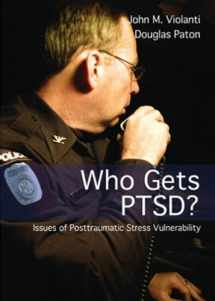
Who Gets PTSD?: Issues of Posttraumatic Stress Vulnerability
ISBN-13:
9780398076191
ISBN-10:
0398076197
Edition:
1
Author:
Douglas Paton, John M. Violanti
Publication date:
2006
Publisher:
Charles C Thomas Pub Ltd
Format:
Paperback
203 pages
FREE US shipping
Book details
ISBN-13:
9780398076191
ISBN-10:
0398076197
Edition:
1
Author:
Douglas Paton, John M. Violanti
Publication date:
2006
Publisher:
Charles C Thomas Pub Ltd
Format:
Paperback
203 pages
Summary
Who Gets PTSD?: Issues of Posttraumatic Stress Vulnerability (ISBN-13: 9780398076191 and ISBN-10: 0398076197), written by authors
Douglas Paton, John M. Violanti, was published by Charles C Thomas Pub Ltd in 2006.
With an overall rating of 3.5 stars, it's a notable title among other
books. You can easily purchase or rent Who Gets PTSD?: Issues of Posttraumatic Stress Vulnerability (Paperback) from BooksRun,
along with many other new and used
books
and textbooks.
And, if you're looking to sell your copy, our current buyback offer is $0.52.
Description
Persons engaged in occupations that require emergency responses must frequently deal with exposure to incidents that are traumatic. Some of these persons develop posttraumatic stress reactions or full-blown posttraumatic stress disorder, while others do not. A key issue in the development of traumatic stress is vulnerability. This book draws from research and life experiences on trauma vulnerability to better understand how mental health professionals and those concerned with the psychological well-being of others may disentangle the perplexing questions of who gets PTSD, why they do, and how we may prevent or minimize this from happening. Major topics in the text include: assessing psychological distress and physiological vulnerability in police officers; personal, organizational, and contextual influences in stress vulnerability; differences in vulnerability to posttraumatic deprivation; gender differences in police work stress and trauma; trauma types, frequency of exposure, and gender differences; personal, event, and organizational influences in police stress vulnerability; vulnerability, war, and prisoner abuse; reducing trauma through personal and response management; psychological vulnerability among international aid workers; prolonged separation and family vulnerability; risk communication and equilibrium theory; a statistical model for measuring trauma vulnerability; and traumatic stress in protective services professions. What is clear from the chapters that comprise this volume is that vulnerability should be conceptualized as a multilevel phenomenon, and the text identifies the contributing levels of analysis that provides the foundation for this process. The text will serve as a valuable resource to professionals in law enforcement, emergency and paramedical services, and the military, as well as to psychologists, psychiatrists, and counselors.


We would LOVE it if you could help us and other readers by reviewing the book
Book review

Congratulations! We have received your book review.
{user}
{createdAt}
by {truncated_author}


